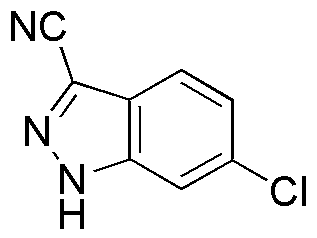6-Chloro-1H-indazole-3-carbonitrile is widely utilized in research focused on:
- Pharmaceutical Development: This compound serves as a key intermediate in the synthesis of various pharmaceuticals, particularly in developing new treatments for cancer and other diseases.
- Agricultural Chemicals: It is used in the formulation of agrochemicals, contributing to the development of effective herbicides and pesticides that enhance crop yield and protect against pests.
- Biochemical Research: Researchers employ this compound to study its interactions with biological systems, helping to uncover mechanisms of action for potential therapeutic agents.
- Material Science: The compound is explored for its properties in creating advanced materials, including polymers and coatings that require specific chemical stability and durability.
- Analytical Chemistry: It is utilized as a standard reference material in analytical methods, aiding in the development of reliable testing protocols for various chemical analyses.
General Information
Properties
Safety and Regulations
Applications
6-Chloro-1H-indazole-3-carbonitrile is widely utilized in research focused on:
- Pharmaceutical Development: This compound serves as a key intermediate in the synthesis of various pharmaceuticals, particularly in developing new treatments for cancer and other diseases.
- Agricultural Chemicals: It is used in the formulation of agrochemicals, contributing to the development of effective herbicides and pesticides that enhance crop yield and protect against pests.
- Biochemical Research: Researchers employ this compound to study its interactions with biological systems, helping to uncover mechanisms of action for potential therapeutic agents.
- Material Science: The compound is explored for its properties in creating advanced materials, including polymers and coatings that require specific chemical stability and durability.
- Analytical Chemistry: It is utilized as a standard reference material in analytical methods, aiding in the development of reliable testing protocols for various chemical analyses.
Documents
Safety Data Sheets (SDS)
The SDS provides comprehensive safety information on handling, storage, and disposal of the product.
Product Specification (PS)
The PS provides a comprehensive breakdown of the product’s properties, including chemical composition, physical state, purity, and storage requirements. It also details acceptable quality ranges and the product's intended applications.
Certificates of Analysis (COA)
Search for Certificates of Analysis (COA) by entering the products Lot Number. Lot and Batch Numbers can be found on a product’s label following the words ‘Lot’ or ‘Batch’.
*Catalog Number
*Lot Number
Certificates Of Origin (COO)
This COO confirms the country where the product was manufactured, and also details the materials and components used in it and whether it is derived from natural, synthetic, or other specific sources. This certificate may be required for customs, trade, and regulatory compliance.
*Catalog Number
*Lot Number
Safety Data Sheets (SDS)
The SDS provides comprehensive safety information on handling, storage, and disposal of the product.
DownloadProduct Specification (PS)
The PS provides a comprehensive breakdown of the product’s properties, including chemical composition, physical state, purity, and storage requirements. It also details acceptable quality ranges and the product's intended applications.
DownloadCertificates of Analysis (COA)
Search for Certificates of Analysis (COA) by entering the products Lot Number. Lot and Batch Numbers can be found on a product’s label following the words ‘Lot’ or ‘Batch’.
*Catalog Number
*Lot Number
Certificates Of Origin (COO)
This COO confirms the country where the product was manufactured, and also details the materials and components used in it and whether it is derived from natural, synthetic, or other specific sources. This certificate may be required for customs, trade, and regulatory compliance.


